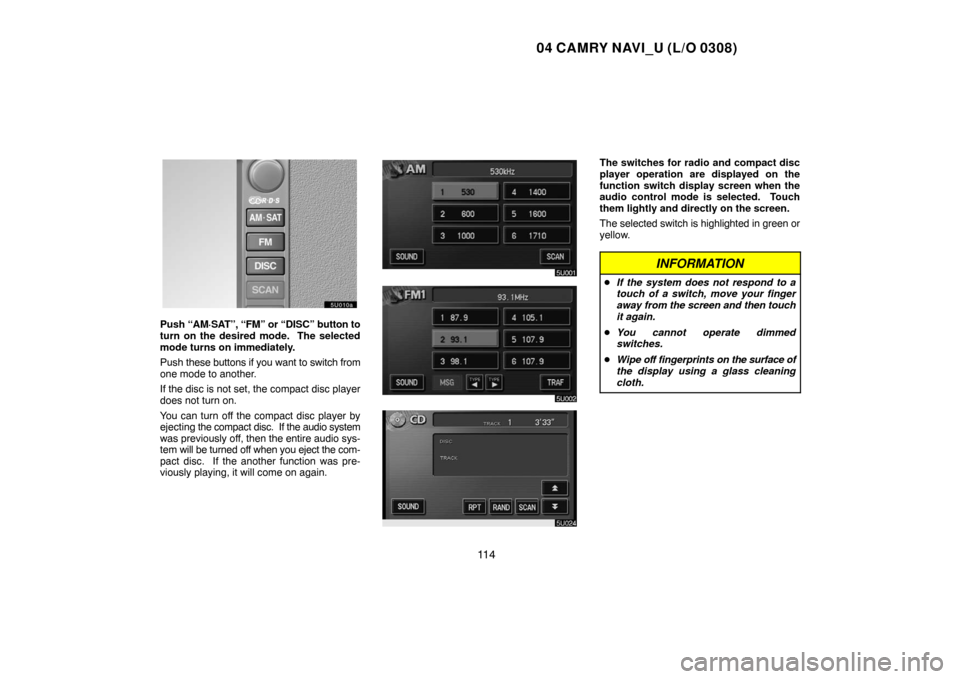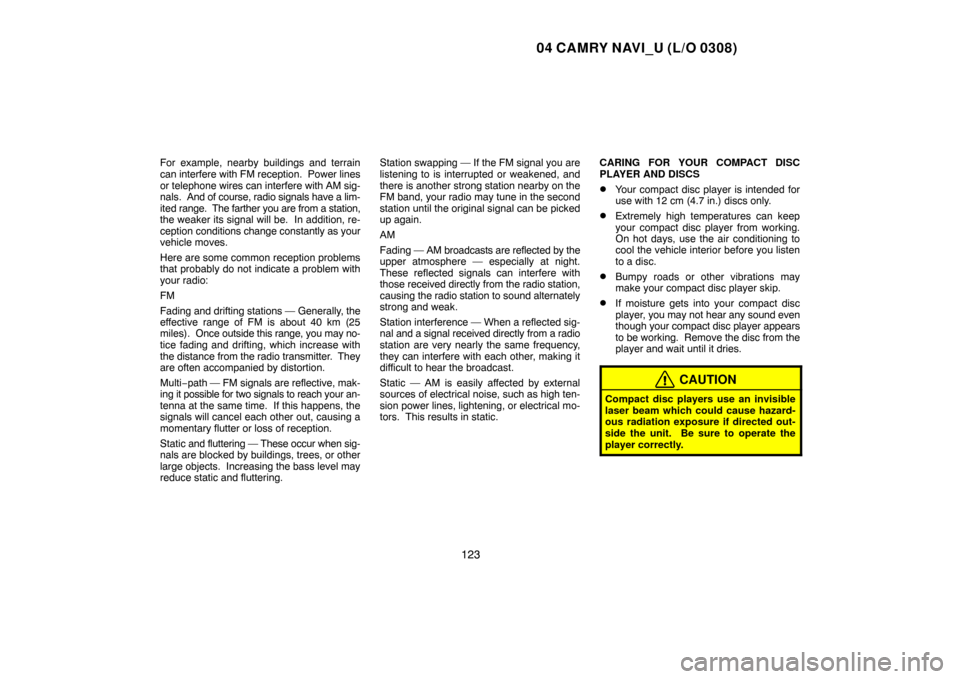Page 124 of 135

04 CAMRY NAVI_U (L/O 0308)
11 4
Push “AM·SAT”, “FM” or “DISC” button to
turn on the desired mode. The selected
mode turns on immediately.
Push these buttons if you want to switch from
one mode to another.
If the disc is not set, the compact disc player
does not turn on.
You can turn off the compact disc player by
ejecting the compact disc. If the audio system
was previously off, then the entire audio sys-
tem will be turned off when you eject the com-
pact disc. If the another function was pre-
viously playing, it will come on again.
The switches for radio and compact disc
player operation are displayed on the
function switch display screen when the
audio control mode is selected. Touch
them lightly and directly on the screen.
The selected switch is highlighted in green or
yellow.
INFORMATION
�If the system does not respond to a
touch of a switch, move your finger
away from the screen and then touch
it again.
�You cannot operate dimmed
switches.
�Wipe off fingerprints on the surface of
the display using a glass cleaning
cloth.
Page 127 of 135

04 CAMRY NAVI_U (L/O 0308)
11 7
(c) Selecting a station
Tune in the desired station using one of the
following methods.
Preset tuning: Touch the switch (1 — 6) for
the station you want. The switch is high-
lighted in green and the station frequency ap-
pears on the screen.
Seek tuning: Push the “SEEK/TRACK” but-
ton on either side. The radio will begin seek-
ing up or down for a station of the nearest fre-
quency and will stop on reception. Each time
you push the button, the stations will be
searched out one after another.
To scan all the frequencies: Touch the
“SCAN” switch on the screen or push the
“SCAN” button briefly. “SCAN” appears on
the screen. The radio will find the next station
and stay there for a few seconds, and then
scan again. To select a station, touch the
“SCAN” switch or push the “SCAN” button
again.
To scan the preset stations: Touch the
“SCAN” switch on the screen or push the
“SCAN” button for longer than approximately
a second. “P. SCAN” appears on the screen.
The radio will tune in the next preset station,
stay there for a few seconds, and then move
to the next preset station. To select a station,
touch the “SCAN” switch or push the “SCAN”
button again.(d) Radio Data System
Your audio system is equipped with Radio
Data Systems (RDS). RDS mode provides
you to receive text messages from radio sta-
tions that utilize RDS transmitters.
When RDS is on, the radio can
— only select stations of a particular program
type,
— display messages from radio stations,
— search for a stronger signal station.
RDS features are available for the use only on
FM stations which broadcast RDS informa-
tion.“TYPE SEEK” switch
This switch allows you to search all available
RDS stations out of the entire FM band and
sort them by program type (See following
“TYPE � �” switch for details on program
types).
By touching this switch at the FM mode, RDS
is turned on and the radio is switched to FM
type mode. During the program type search,
“TYPE SEEK” will be shown on the screen.
After searching for all the available RDS sta-
tions, the radio will activate the previously
used program type. If the previously used
program type is not available, or if the radio
has not yet performed a program type search,
the radio will activate the first available pro-
gram type that has stations in memory. The
radio will preset the stations of the current
program type into the preset switches.
These are accessible through the “TYPE �
�” switch. If more than 6 stations are found,
the radio will load the 6 strongest stations sig-
nal of the program type into the presets.
If no RDS stations are found, “NOTHING” will
be displayed. Then the radio will return to the
previous FM mode and frequency.
Page 133 of 135

04 CAMRY NAVI_U (L/O 0308)
123
For example, nearby buildings and terrain
can interfere with FM reception. Power lines
or telephone wires can interfere with AM sig-
nals. And of course, radio signals have a lim-
ited range. The farther you are from a station,
the weaker its signal will be. In addition, re-
ception conditions change constantly as your
vehicle moves.
Here are some common reception problems
that probably do not indicate a problem with
your radio:
FM
Fading and drifting stations — Generally, the
effective range of FM is about 40 km (25
miles). Once outside this range, you may no-
tice fading and drifting, which increase with
the distance from the radio transmitter. They
are often accompanied by distortion.
Multi−path — FM signals are reflective, mak-
ing it possible for two signals to reach your an-
tenna at the same time. If this happens, the
signals will cancel each other out, causing a
momentary flutter or loss of reception.
Static and fluttering — These occur when sig-
nals are blocked by buildings, trees, or other
large objects. Increasing the bass level may
reduce static and fluttering.Station swapping — If the FM signal you are
listening to is interrupted or weakened, and
there is another strong station nearby on the
FM band, your radio may tune in the second
station until the original signal can be picked
up again.
AM
Fading — AM broadcasts are reflected by the
upper atmosphere — especially at night.
These reflected signals can interfere with
those received directly from the radio station,
causing the radio station to sound alternately
strong and weak.
Station interference — When a reflected sig-
nal and a signal received directly from a radio
station are very nearly the same frequency,
they can interfere with each other, making it
difficult to hear the broadcast.
Static — AM is easily affected by external
sources of electrical noise, such as high ten-
sion power lines, lightening, or electrical mo-
tors. This results in static.CARING FOR YOUR COMPACT DISC
PLAYER AND DISCS
�Your compact disc player is intended for
use with 12 cm (4.7 in.) discs only.
�Extremely high temperatures can keep
your compact disc player from working.
On hot days, use the air conditioning to
cool the vehicle interior before you listen
to a disc.
�Bumpy roads or other vibrations may
make your compact disc player skip.
�If moisture gets into your compact disc
player, you may not hear any sound even
though your compact disc player appears
to be working. Remove the disc from the
player and wait until it dries.
CAUTION
Compact disc players use an invisible
laser beam which could cause hazard-
ous radiation exposure if directed out-
side the unit. Be sure to operate the
player correctly.
Page 135 of 135
04 CAMRY NAVI_U (L/O 0308)
125
�Correct�Wrong
�Handle compact discs carefully, especial-
ly when you are inserting them. Hold them
on the edge and do not bend them. Avoid
getting fingerprints on them, particularly
on the shiny side.
�Dirt, scrapes, warping, pin holes, or other
disc damage could cause the player to
skip or to repeat a section of a track. (To
see a pin hole, hold the disc up to the
light.)
�Remove discs from the compact disc
player when you are not listening to them.
Store them in their plastic cases away
from moisture, heat, and direct sunlight.
To clean a compact disc: Wipe it with a soft,
lint−free cloth that has been dampened with
water. Wipe in a straight line from the center
to the edge of the disc (not in circles). Dry it
with another soft, lint−free cloth. Do not use
a conventional record cleaner or anti−static
device.